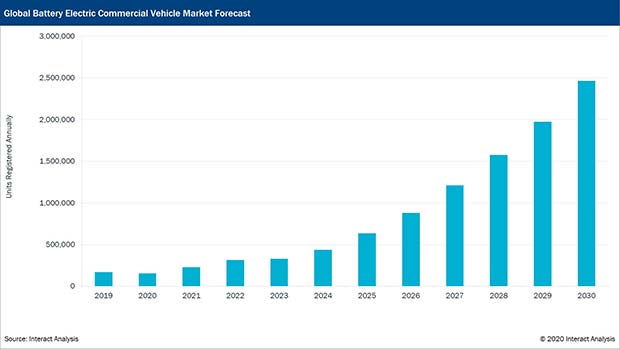Interact Analysis has completed its latest in-depth report on the commercial vehicle sector, with a particular focus on the battery electric and hybrid market. After a severe COVID-induced setback in 2020, the industry is predicted to make a swift recovery in 2021. Hybridisation is the favoured solution for most long-distance vehicles; while full electric is preferred for city buses and last-mile delivery vehicles.
 After a 7% decline in the market for battery-electric commercial vehicles in 2020, which was the continuation of a decline in 2019 and was largely due to Chinese subsidy policies, the sector will bounce back in 2021. Interact Analysis says that though sales dipped from 168,000 in 2019 to around 156,000 in 2020, the projected global sales figure for 2021 stands at nearly 231,000 units – a stunning 47% growth for the sector. This is driven by growth in Europe and North America, along with the extension of China’s EV subsidy program which was meant to come to an end in 2020. APAC will be streets ahead in 2021, surpassing the 2019 global figure with over 171,000 sales. Europe will be second in this league table, with a projected 44,000 new electric vehicle registrations in 2021. The total truck and bus market (battery-electric, fuel cell, hybrid and diesel) will decline by 16% in 2020 but will see 15% growth in 2021.
After a 7% decline in the market for battery-electric commercial vehicles in 2020, which was the continuation of a decline in 2019 and was largely due to Chinese subsidy policies, the sector will bounce back in 2021. Interact Analysis says that though sales dipped from 168,000 in 2019 to around 156,000 in 2020, the projected global sales figure for 2021 stands at nearly 231,000 units – a stunning 47% growth for the sector. This is driven by growth in Europe and North America, along with the extension of China’s EV subsidy program which was meant to come to an end in 2020. APAC will be streets ahead in 2021, surpassing the 2019 global figure with over 171,000 sales. Europe will be second in this league table, with a projected 44,000 new electric vehicle registrations in 2021. The total truck and bus market (battery-electric, fuel cell, hybrid and diesel) will decline by 16% in 2020 but will see 15% growth in 2021.
Interact Analysis forecasts that electrified powertrains – hybrid, fuel cell and battery electric – will account for over 2.5 million annual registrations of commercial vehicles by 2030, out of a total of over 20 million. Battery electric powertrains are predicted to make serious inroads in the city bus and light duty vehicle sectors, notably last-mile delivery vehicles, reflecting the anticipated lasting boom in online-shopping caused by the pandemic. Inter-city bus fleets and long-haul trucks where pure battery electric is not always a viable option are predicted to see an increasing use of fuel cell technology.





Comments are closed.